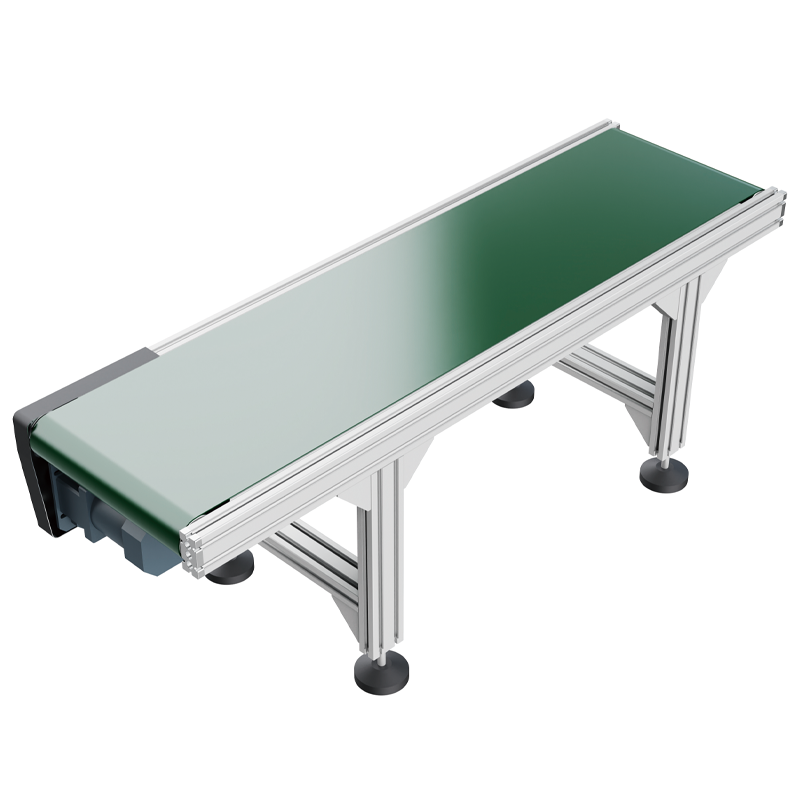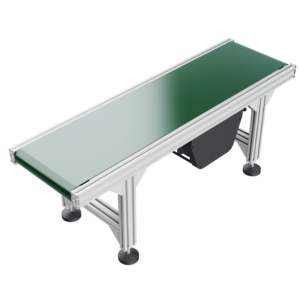Heavy duty belt conveyor is with 30 series t slot profiles. The structure is simple and beatiful, also convinient to assemble.
Description
What is Belt Conveyor?

Belt conveyor is a kind of friction-driven machine. And manufacturers use it to conveying materials continuously. A frame, conveyor belt, roller, roller, tensioning device, transmission device, etc are its parts. Also It can form a material conveying process from the firsr supply point to the final discharge point on a certain conveyor line. It can convey both tiny materials and finished products.
Besides material conveying, it can also form a rhythmic flow operation conveying line with the requirements of the production processes in various industrial fields.
Convoyeur, plays an important role across numerous sectors. It is including home appliances, électronique, electrical devices, machinery, tobacco, injection molding. As well as the postal and telecommunications services. It’s an indispensable tool in the assembly, testing, debugging, packaging, and transport processes. And it is also in streamlining operations and enhancing efficiency in production lines everywhere.
We can select line conveying according to process requirements. Par exemple, ordinary continuous operation, rhythmic operation, variable speed operation and other control methods. So we can select line conveying according to local conditions: straight lines, courbes, slopes and other linear forms of conveying equipment.
More About Belt Conveyor
As we can see, it is an indispensable economical logistics transportation equipment that forms a rhythmic assembly line.
According to their conveying capacity, belt conveyors can be divided into heavy-duty belt conveyors, such as mining belt conveyors. And light-duty belt conveyors, such as those used in electronic plastics, food and light industry, chemical and pharmaceutical industries.
The belt conveyor has strong conveying capacity, long conveying distance, simple structure and easy maintenance, and can conveniently implement programmed control and automated operation. Usually we use the continuous or intermittent movement of the conveyor belt to transport items below 100KG or powdery and granular items.So it runs at high speed, smoothly, has low noise, and can be transported up and down slopes.
Belt Conveyor Specifications:
Model Conveyor Length L Conveying Width W Conveyor Height H Conveyor Speed V Speed Control
TOSH-BE-30E 0.6~6m 80~400mm As needed 40m/min Max 40m/min Constant speed F/ Variable speed V
caractéristiques du produit:
- Constructed with 30 series aluminum profiles and components, allowing easy integration with other complementary mechanisms like guardrails, sensors, etc..
- End-driven unit enabling unidirectional conveying with a maximum load capacity of 40KG.
- Manual adjustment for end tensioning, providing simplicity and convenience.
- Recommended operational speed is below 20m/min for optimal lifespan; exceeding this limit may reduce the product’s longevity.
- Guardrails are available in fixed and adjustable widths, selectable as per specific requirements.
Description dimensionnelle:

Belt Conveyor Application:
Belt conveyor, known for its high throughput, simple structure, easy maintenance, and standardized components, boasts various advantages. It finds wide applications across industries. Such as home appliances, électronique, machinery, tobacco, injection molding, telecommunications, printing, and food. It’s utilized for conveying loose materials or assembled items.
According to the requirements of the conveying process, we can use it as a standalone unit. Or can be combined with multiple units or other conveying equipment to form horizontal or inclined conveying systems, catering to the diverse layout needs of production lines.
Maintaining a Convoyeur‘s Operational Integrity
Critical to the belt conveyor’s reliability is the proactive identification and rectification of any faults. Operators are tasked with constant vigilance, monitoring its function and promptly addressing any issues. Regular inspections by maintenance personnel are mandatory to preempt and prevent potential breakdowns. Even components that may seem minor, like a roller, can have a significant impact.
If a high-speed conveyor belt transports abrasive materials, for example, rapid deterioration of its housing could occur, leading to severe damage that could compromise an expensive belt.
En un mot, proper training of personnel is essential. As skilled workers are the first line of defense against imminent breakdowns, with the ability to detect and neutralize hazards before they escalate. The conveyor belt represents a significant portion of the system’s overall costs.
Investing in operator and maintenance staff education on the nuances of conveyor belt management is vital. Not only for the system’s longevity but also to mitigate expenses associated with belt replacement and repairs.
Development Trends of Conveyors
In the future, conveyors will develop towards large-scale development, expanding the scope of use, automatic sorting of materials, reducing energy consumption, reducing pollution, etc..
- Continue to develop towards large-scale. Large-scale includes several aspects such as large conveying capacity, large unit length and large conveying inclination. And the length of the hydraulic conveying device has reached more than 440 kilometers. The length of a single belt conveyor is nearly 15 kilometers. And several units have appeared to form a “convoyeur à bande” connecting the two places. Many countries are exploring more complete conveyor structures for continuous transportation of materials over long distances and large volumes.
- Expand the scope of use of the conveyor. Develop conveyors that can work under high and low temperatures, in environments with corrosive, radioactive. And flammable substances, and that can transport hot, explosive, agglomerating, and sticky materials.
- Make the structure of the conveyor meet the requirements of the automated control of the material handling system for a single machine. Par exemple, the trolley conveyor used by the post office to automatically sort parcels should be able to meet the requirements of sorting actions.
- Reducing energy consumption to save energy has become an important aspect of scientific research in the field of transportation technology. The energy consumed by transporting 1 ton of material for 1 km has been used as one of the important indicators for conveyor selection.
- Reduce the dust, noise and waste gas emitted by various conveyors during operation.
Donc, if you wanna learn some thing about belt conveyors, please contact us.





